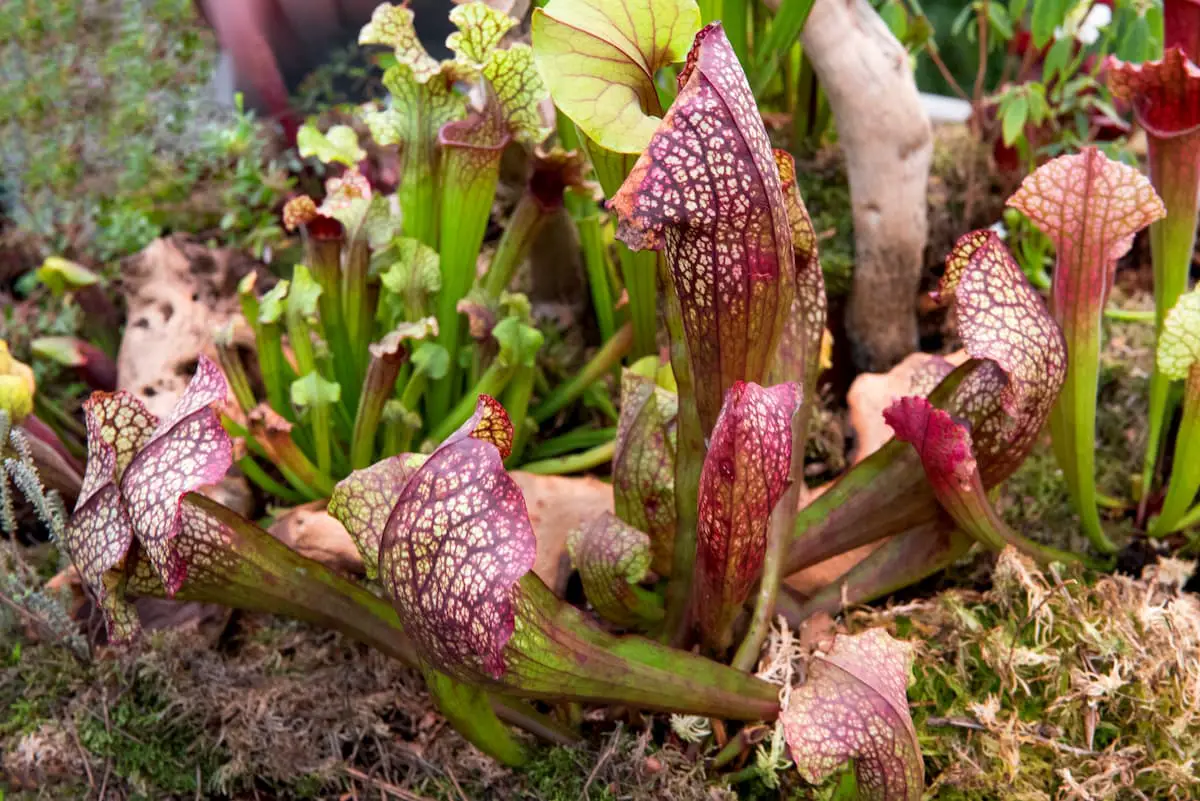Are you a budding plant enthusiast looking to add some unique greenery to your home? If so, then a pitcher plant could be a perfect choice!
This pitcher plant care guide will provide you with all the tips and tricks you need to care for your pitcher plants properly. So, let’s get started!
Choose the Right Variety of Pitcher Plant
Making sure you choose the right variety of pitcher plant is essential for successful care and growth. Different varieties have different requirements when it comes to soil, light and temperature.
Identifying the type of Pitcher Plant you have is the first step in creating the perfect environment for your plant to thrive.
Once you have identified the type of Pitcher Plant, you can then better understand the soil, light and temperature requirements.
Of course, the container size is also an important factor to consider when choosing a pot.
Identifying the right variety of pitcher plant
Identifying the right variety of pitcher plant can be a daunting task. With so many varieties of pitcher plants available, it can be difficult to know which one is best suited for your needs.
Before you start shopping for a pitcher plant, it’s important to do some research to make sure you choose the right variety for you.
Consider factors such as the size of the plant, the amount of light and temperature it needs, and its soil requirements.
Once you have identified the right variety for you, you can move on to the next step in caring for your pitcher plant.
Understanding the soil requirements for different varieties
When it comes to understanding the soil requirements for different varieties of pitcher plants, it is important to choose the right variety for your environment.
Different pitcher plant varieties have different soil needs and preferences, so it is important to do research on the variety you are considering growing.
Some varieties may require different soil types, including sandy, loamy, or clay soils, as well as different levels of drainage and moisture.
Other pitcher plants may also require additional fertilizers or supplements in order to thrive. Doing your research before selecting the variety that is right for you is the best way to ensure successful growth.
Understanding the light and temperature requirements for different varieties
When choosing the right variety of pitcher plant, it is important to understand the specific light and temperature requirements for each type.
Depending on the variety, some pitcher plants will prefer full sun or partial shade, while others will require bright but indirect light.
The temperature should also be taken into account, as some varieties are more sensitive to extreme temperatures than others.
For example, tropical pitcher plants typically require temperatures between 60 and 85 degrees Fahrenheit, while temperate varieties need temperatures between 50 and 75 degrees.
By researching the individual needs of each variety, you can make sure that you are providing the optimum conditions for your pitcher plant.
Factors to consider when choosing a pot size
When it comes to choosing the right variety of pitcher plant, there are a few things to consider. First, you should decide which type of pitcher plant is best for your space and needs.
There are many varieties of pitcher plants, each with its own unique characteristics. Some varieties are more tolerant of colder temperatures while others prefer warmer climates.
Additionally, some varieties require more light and humidity than others. Researching the different varieties of pitcher plants and their various needs will help you make an informed decision when selecting the right variety of pitcher plant for your home.
Provide Adequate Light and Temperature
Light is an essential factor when it comes to growing pitcher plants, and Nepenthes ventrata is no exception.
This pitcher plant needs at least 10 hours of light to remain healthy. For best results, give your plant around 4 hours of direct sunlight in the morning, followed by bright, indirect light for the rest of the day.
It’s also important to keep the growing space temperature consistent, as pitcher plants tend to do best in warm climates. Aim to keep the temperature at a minimum of 60 degrees Fahrenheit.
Create an Optimal Humidity Level
Humidity is an important factor in creating the right environment for pitcher plants. To create an optimal humidity level, you should keep your pitcher plants in a room with a relative humidity of between 40 and 70%.
Consider using a humidifier or misting your pitcher plants regularly to maintain the desired humidity levels.
Additionally, you can use pebbles and water in the potting medium to help retain moisture.
Feed Pitcher Plants Appropriately
The right nutrition is essential for pitcher plants to thrive. While they do not need to be fed regularly, they should be offered some food sources occasionally.
Insects are the best food source for pitcher plants, but they can also be fed with a nutrient-rich fertilizer. Make sure to feed them only in small amounts and always avoid overfeeding, as this can cause root rot.
Additionally, it is important to ensure that the food source is suitable for the particular variety of pitcher plant.
Be sure to research the best food sources for the specific variety of pitcher plant you have.
Provide the Right Potting Medium
The potting medium for pitcher plants is as important as the growing conditions. The type of soil you use can make a big difference in the health of the plant.
It should be well-draining and made up of equal parts of peat moss, sand, and perlite. Adding a bit of lime or dolomitic limestone will help to keep the soil pH balanced and reduce the acidity of the soil.
You should also add some organic matter to the soil, such as compost or manure, to ensure that your pitcher plant gets the right nutrients.
Make sure to water your potted pitcher plant thoroughly to ensure that the soil is evenly moist before repotting.
Water Pitcher Plants Properly
Watering your pitcher plant is an important part of its care. It’s important to keep the soil consistently moist, but not soggy.
When the top 25% of the potting soil is dry, it’s time to water. Make sure you allow the pot to drain so the plant isn’t sitting in water.
It’s also important to provide humidity for your pitcher plant, as this helps it to retain moisture. You can do this by misting the plant with water or placing a tray of water beneath the pot.
Additionally, adding a layer of mulch over the soil can help keep the moisture in and discourage weed growth.
Fertilize Pitcher Plants Sparingly
Fertilizing pitcher plants is an important part of their care and maintenance. The key is to fertilize sparingly, as too much fertilization can lead to root burn or nutrient toxicity.
The best fertilizer for pitcher plants is a water-soluble fertilizer with a balanced NPK ratio, such as a 10-10-10 or 20-20-20 formulation.
To fertilize, mix the fertilizer at a rate of 1 tsp per gallon of water and apply it directly to the soil. Avoid fertilizing during the winter months, as this can be too harsh for the plant.
Keep Pitcher Plants Free of Pests and Diseases
Pitcher plants are generally very resilient and don’t attract many pests, but it’s important to keep an eye out for any signs of an infestation.
To prevent pests, only use sterilized soil and avoid using any fertilizer that may attract pests. Additionally, make sure you inspect your plant regularly and remove any dead leaves or debris.
If you do notice any pests, you should immediately isolate the plant and treat it with an appropriate insecticide. Additionally, you should be aware of any signs of disease and treat the plant accordingly.
By following these preventative steps, you can keep your pitcher plants free of pests and diseases.
Repot Pitcher Plants Regularly
Repotting your pitcher plant is an essential part of its care. Repotting is important because it allows the plant to have access to fresh soil and more space to grow.
It is recommended to repot your pitcher plant every one to two years, depending on its size. When repotting, be sure to use a potting mix specifically designed for carnivorous plants.
This type of soil will provide the necessary nutrients to your plant, as well as adequate drainage. Be sure to provide your pitcher plant with adequate light and temperature after repotting to ensure it can adjust to its new environment.
Additionally, make sure to water your pitcher plant regularly and fertilize sparingly to maintain optimal health.
Propagate Pitcher Plants Successfully
Propagating pitcher plants is a great way to increase your collection of these fascinating carnivorous plants.
Pitcher plants can be propagated by a variety of methods, such as vegetative cuttings and leaf cuttings, or by dividing the plant.
It is important to provide the right conditions for propagating pitcher plants to ensure a successful outcome.
Make sure to provide plenty of light and warmth, as well as a nutrient-poor growing medium.
Additionally, it is important to keep the humidity high and water regularly to keep the cutting or divided plant moist.
With the right conditions and a little patience, you will be rewarded with a new pitcher plant in no time!




Leave a Reply